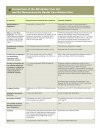Employer Articles
A new generation without an official moniker and relatively unknown to the larger corporate society of the United States is trudging through the American education system just like millions of others before them, and they are just starting to think about what they want to do with their lives.
Published in
Human Resources
The Five Star Qualities That Today’s Employer Wants to See in Candidates
Posted by Christopher Lihzis
A recent and very extensive survey by Universum, the employer branding firm, (reported in Forbes) surveyed 1,200 of the world’s leading employers to find out exactly what personal qualities today’s big businesses are looking for in candidates. They were asking employers what they were looking for and equally what they were failing to find; so, this survey is a great up-to-the -minute snapshot of what qualities candidates must exhibit to raise the eyebrows of employers and make it through the sift and interview process. So, what were these elusive qualities?
Published in
Employee Screening
A critical component of the Border Security, Economic Opportunity, and Immigration Modernization Act (S.744), introduced April 17, 2013, is a provision that would require all employers to participate in an enhanced E-Verify-type program.
Published in
Human Resources
Many of the nation’s employers are still on the fence concerning the “Play or Pay” question in health care reform. Some are leaning toward “Play” (offering employees medical coverage that meets the requirements of the Patient Protection and Affordable Care Act [PPACA]), while others are favoring “Pay” (forking over penalties for not offering acceptable coverage to employees). The law actually calls for two possible penalties for large employers with 50 or more employees: one for not offering “minimum essential” coverage, and the other for offering coverage that isn’t “affordable” and/or doesn’t provide “minimum value.”
Published in
Human Resources
Get this exclusive Alpha Business Brief comparing provisions of the Massachusetts Health Care Reform Plan to the Federal (PPACA) requirements in one concise document.
Published in
Human Resources
The Affordable Care Act does not require businesses to provide health benefits to their workers, but larger employers face penalties starting in 2014 if they don't make affordable coverage available. This simple flowchart illustrates how those employer responsibilities work.
Published in
Human Resources
The Affordable Care Act will reduce the number of people without health insurance by expanding eligibility for Medicaid and providing tax credits that make insurance more affordable for people buying coverage on their own through new health insurance Exchanges. The Congressional Budget Office projects that 32 million more people will have insurance by 2019. Find out who gets covered and how with this simple flowchart, created as part of the Visualizing Health Policy series with The Journal of the American Medical Association.
Published in
Human Resources
There are an estimated 80 million young Americans who belong to the so-called millennial generation, roughly ages 18 to 35. By next year, they are expected to comprise 36% of the U.S. workforce, and by 2020, millennials will be nearly half of all workers. While millennials are the most educated and culturally diverse of any generation before them, they’re also notorious job-hoppers who dislike bureaucracy and distrust traditional hierarchies—leaving many business leaders scratching their heads. What motivates this rising cohort? How do you keep them engaged, earn their trust and get the most out them? Leadership and millennial experts weighed in with a few surprising—and surprisingly easy—ways to inspire millennial workers.
Published in
Workforce Management
More...
This legislation comes as a shot to business groups, many of whom regard credit checks as a safeguard against hiring people who may have trouble with money for positions of trust that involving the handling of money. According to a 2012 SHRM survey, among organizations that initiate credit background checks, 87 percent do so for positions with financial responsibilities.
Published in
Employee Screening
It’s not easy being a manager these days. You’re responsible for recruiting, hiring, training, coaching, modeling, engaging, monitoring, motivating, anticipating, prioritizing, planning, evaluating, clarifying, adapting, envisioning, directing, disciplining, reinforcing, reporting, recognizing, budgeting, and building alliances. And that’s all before lunch. And if you struggle with just one, your reports will say you’re over your head.
Published in
Workforce Management
Have you had any of your employees question you about the DD in box 12 of their W-2? by by Linda Robertson
Published in
Human Resources

